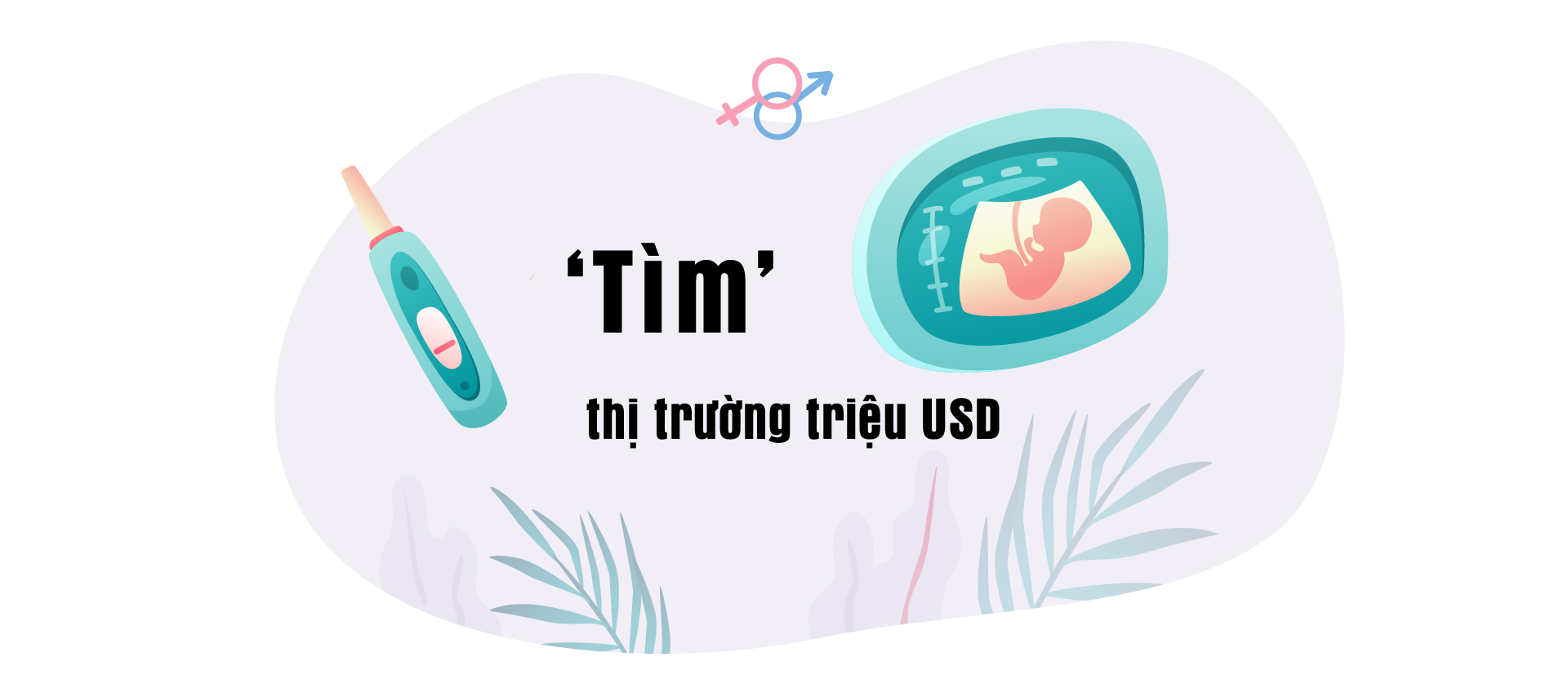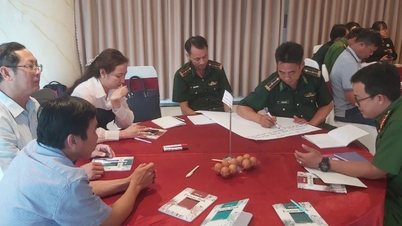For 43-year-old Thai Tien Dung, the most haunting experience for him throughout the past 17 years, every time his wife was pregnant, was the doctor's statement about "terminating the pregnancy."

Married since 2006, Dũng's wife (from Ho Chi Minh City) suffered two miscarriages within three years for unknown reasons. Five years later, the family welcomed their first son, but their joy was short-lived.
On the day his child died, he hid it from his wife, quietly returning home to clear out all the baby supplies they had bought earlier. His wife, whose stitches from her postpartum surgery had just been removed, had to say goodbye to her newborn child, who was only 14 days old.
"The baby couldn't survive," Mr. Dung recounted. His child died from a brain hemorrhage caused by a rare congenital disorder, identified as a deficiency in clotting factor 7.
Both he and his wife carry a recessive gene mutation – a very rare case, occurring in only 300,000-500,000 people. Their child has a 25% chance of being born with a clotting factor deficiency. Mild cases result in gastrointestinal bleeding, while severe cases can lead to brain hemorrhage, making survival difficult even in the first few months after birth. Mr. Dung's child falls into this 25% category.
Since then, they embarked on a decade of relentless pursuit to realize their dream of parenthood. The couple would have had seven children if all of them had been born healthy.

Two years after losing their first child, his wife became pregnant for the fourth time, but her old illness persisted. Out of love for his wife, he followed the doctor's advice and agreed to terminate the pregnancy.
Not giving up hope, in 2015, his wife became pregnant for the fifth time. When the fetus was 16 weeks old, the doctor discovered the same condition again and once more advised terminating the pregnancy. But this time, they were determined to keep the child.
"We accept the trade-off for the feeling of holding a child in our arms, even if they are not healthy or don't have much time left to live," he said. Having lost four children, they longed for a child of their own.
At two years old, the child lived "like a tree," lying still in one place for blood transfusions, unable to speak. The couple sold their house and moved closer to the hospital to seek treatment for their child. But all their efforts were in vain. The child gradually weakened and passed away at the age of four. Once again, the couple had to say goodbye to their own flesh and blood.
According to the Ministry of Health , the infertility rate among couples of reproductive age in Vietnam is 7.7% – approximately one million couples. Of these, over 50% are secondary infertility cases, meaning they have been pregnant or given birth at least once but are unable to conceive again, an increase of 15-20% annually. Mr. Dung and his wife are among these couples. Unlike couples with primary infertility (not conceiving after one year of marriage), Mr. Dung's family faces a more difficult situation: they are pregnant, but are hesitant to have the child.
The yearning for children among couples like Mr. Dung has been the driving force behind the development of the infertility treatment industry over the past three decades, turning it into a multi-million dollar industry in Vietnam.

"Each time I counseled the couple on terminating a pregnancy, it was really difficult, because I knew Dung's wife desperately wanted to be a mother. After losing their child, both of them became depressed. I urged them to seek treatment, and then return for in-vitro fertilization (IVF). At least there was still hope," said Dr. Quach Thi Hoang Oanh (Deputy Head of the Medical Genetics Testing Department, Tu Du Hospital) - who has been treating Dung and his wife since 2011.
IVF is an assisted reproductive method that combines the husband's sperm and the wife's egg in a laboratory, then transfers the resulting embryo into the uterus to begin a pregnancy. This is a central technique addressing most causes of infertility in Vietnam.
Mr. Dung researched how similar cases were handled around the world and learned about the advanced techniques of IVF that help "read" abnormalities in genes and chromosomes, called preimplantation genetic diagnosis (PGT) . Thanks to this, doctors can screen and select healthy embryos, free from inherited disease genes, to transfer into the mother's uterus. He planned to take his wife to Malaysia for treatment.
But luck smiled upon them. At the end of 2019, Tu Du Hospital made a breakthrough in IVF technology when it successfully performed the first PGT (Positive Genital Transplantation) procedure, opening a door of hope for the couple. The first attempt only selected one embryo, which was unsuccessful. Undeterred, a year later, when Mr. Dung was over 40 and his wife was 39, they decided to try again.
"My wife and I didn't give up," he said.
Having selected two embryos to be implanted in the mother's uterus, both the doctor and the patient were anxious. At week 16, amniotic fluid testing showed that although the embryos were not completely normal, they both carried recessive genes like their parents, meaning the babies could be born and grow up healthy. Two years after losing their fifth child, they were filled with renewed hope.
In May 2022, the baby was born, and the couple became parents once again. They could hardly believe it when they held their child in their arms."This is the only time I've been able to bring a healthy baby home," Mr. Dung said, unable to hide his emotion, speaking about the moment he finally relieved himself of a burden that had lasted for a decade. In total, his family spent more than 2 billion VND on their dream of becoming parents.

Dung's child is among more than 16,300 "test-tube babies" born over the past 30 years thanks to IVF technology at Tu Du Hospital - the place that laid the foundation for infertility treatment in Vietnam.
"Back then, IVF was a foreign concept, met with fierce opposition because the government was focusing on family planning, contraception, and sterilization," recalled Professor Dr. Nguyen Thi Ngoc Phuong (former director of Tu Du Hospital).
Having interacted with thousands of infertile couples since the 1980s, Dr. Phuong saw infertility as a curse haunting women, severely impacting family happiness. She decided to go against public opinion and find a way to bring infertility treatment technology to Vietnam.

In 1994, she gained access to IVF treatment in France, self-funded the purchase of equipment, and invited a team of experts to Vietnam for support. Four years later, the first three "test-tube babies" were born, marking a historic turning point for the field of infertility treatment.
From a field once met with opposition, IVF has experienced explosive growth from the South to the North, becoming the leading assisted reproductive method nationwide. More than 10 years ago, Vietnam had 18 facilities performing IVF and surrogacy for humanitarian purposes. Since 2010, this number has increased continuously every year and currently stands at 51 units.
According to the Ministry of Health , the assisted reproductive rate (ART) increased from 2.11 in 2010 to 2.29 in 2020 – meaning that on average, for every woman undergoing ART, 2.29 babies are born.
The formation process and map of 51 medical facilities performing IVF in Vietnam.

Dr. Ho Manh Tuong, General Secretary of the Ho Chi Minh City Society of Reproductive Endocrinology and Infertility (HOSREM), stated that Vietnam performs over 50,000 new IVF cases annually, significantly higher than many other countries. Meanwhile, Mr. Nguyen Viet Tien (Chairman of the Vietnam Obstetrics and Gynecology Association, former Deputy Minister of Health), based on sociological statistics, estimates that Vietnam has 1-1.4 million births each year, with approximately 3% (30,000-42,000 babies) resulting from IVF.
According to Dr. Nguyen Viet Quang (Director of the National Center for Assisted Reproductive Technology, National Obstetrics and Gynecology Hospital), this rapid growth stems from three reasons. Firstly, the proliferation of IVF centers from the South to the North has made assisted reproductive methods more accessible to couples. Secondly, the increasing rate of infertility due to medical conditions in both men and women, coupled with exposure to toxic chemicals in the workplace, has increased the risk of infertility.
Finally, there is the development of medical tourism. Vietnam is emerging as a promising destination for tourists seeking medical treatment, including infertility treatment and cosmetic procedures, due to its affordable costs and good service. Travel agencies are also collaborating with hospitals and clinics to design tours that promote the quality of these facilities.
Each embryo transfer currently costs between 70-100 million VND. Costs are similar between public and private hospitals due to the highly competitive nature of the industry. On average, a couple will succeed after 1-2 embryo transfers, but many cases require more. Besides IVF, each assisted reproductive technology (ART) has different costs and success rates, such as genetics, combined screening, IUI (intrauterine insemination), ICSI (intracytoplasmic sperm injection), IVM (in-vitro maturation of immature eggs), embryo and sperm cryopreservation, etc. However, most IVF techniques in Vietnam are among the most affordable in the world.
Cost of IVF treatment in Vietnam and some other countries
After three decades, the national revenue of the IVF industry in 2022 reached over $132 million, projected to achieve an average annual growth rate of 7.47%, according to a report by Research and Market (an international market research company from the US). This rate is higher than the expected growth rate of 5.72% per year for the global IVF market from now until 2030. The report also forecasts that the market value of Vietnam could reach nearly $203 million by 2028.
"Vietnam's infertility treatment is becoming a multi-million dollar industry, projected to experience strong growth between 2023 and 2027," said Dr. Nguyen Viet Quang. Vietnam's infertility treatment center system is currently among the top in Southeast Asia (ASEAN) in terms of the number of cases, and the success rate per IVF cycle has reached 40-50%, a threefold increase compared to the initial period (10-13%). The global rate is currently 40-43%.
Number of IVF cases between Vietnam and some countries around the world

According to former Deputy Minister of Health Nguyen Viet Tien, many infertile patients from abroad have chosen Vietnam as their destination due to the lower costs. Recently, he successfully treated a South African couple in their 40s. The wife suffered from ovulatory dysfunction and blocked fallopian tubes, requiring IVF technology. They recently welcomed their first child. Previously, a Laotian couple who had unsuccessful IVF attempts in Thailand came to Vietnam for treatment and also received good news on their first embryo transfer.
From a professional perspective, Associate Professor Dr. Vuong Thi Ngoc Lan (Faculty of Medicine, Ho Chi Minh City University of Medicine and Pharmacy) stated that many overseas Vietnamese have returned to undergo IVF treatment because Vietnam possesses advanced techniques, even leading the world in IVF. Vietnam also has the highest number of international scientific publications in the region, attracting many doctors and specialists from other countries to learn from its expertise.
"From an economic perspective, infertility treatment is a very promising field," said Dr. Lan.

However, despite advanced techniques and the fact that the total cost of each IVF embryo transfer is only 20-50% of that in other countries in the region, Vietnam is still not an attractive destination on the international infertility treatment map. The reason is believed to be that the medical tourism industry has not been invested in and planned for comprehensive development, mainly developing spontaneously based on demand and potential.
Citing statistics, Dr. Ho Manh Tuong said that every year, Vietnam has about 400 foreigners who come to hospitals and medical centers for infertility examination and treatment (accounting for 1-2%).
This figure is significantly lower than in Thailand, where 60-70% of IVF patients are foreigners. The Tourism Authority of Thailand once announced that artificial insemination services generated at least 20 billion baht (approximately US$611 million) in 2018 for the country, thanks to the development of tourism and resorts combined with IVF treatment. Similarly, in Malaysia, an estimated 30-40% of IVF cases involve foreigners.
Meanwhile, China, which provides over one million IVF cycles resulting in approximately 300,000 babies conceived each year, has announced plans to build IVF facilities capable of serving 2.3 to 3 million people by 2025. This decision comes as the nation faces a series of challenges due to its extremely low birth rate.
In the future, Vietnam risks facing challenges similar to China's, as its fertility rate has nearly halved over the past 30 years, from 3.8 children per woman in 1989 to 2.01 in 2022. Meanwhile, Vietnam has one of the highest infertility rates globally, and it is becoming increasingly prevalent among younger people, according to the World Health Organization (WHO). It is projected that by 2050, people over 60 will account for a quarter of the population, posing a significant challenge in balancing the workforce through population growth.
The declining birth rate trend in Vietnam and China over the past 70 years.
Although IVF costs in Vietnam are cheaper than in the rest of the world, experts believe that the price is still too high for many low-income couples. A single treatment costs the equivalent of an average annual income (nearly 100 million VND in 2022). Meanwhile, a successful case may require multiple embryo transfers, meaning it can cost hundreds of millions to even billions of VND.

Nguyen Thai Manh's (37 years old, Hanoi) 30-square-meter office is filled with thick stacks of neatly arranged medical records. They remind him and his wife of their six-year journey of infertility treatment.
Three years after getting married, the couple discovered they couldn't conceive naturally. Despite taking various supplements, they were unsuccessful and went to the National Center for Reproductive Support at the National Obstetrics and Gynecology Hospital for examination. His wife was diagnosed with blocked fallopian tubes and required surgery. Joyful news arrived a year later when they welcomed their first child.
Their journey to have a second child was fraught with difficulties. In 2016, the couple wanted to conceive naturally but failed several times. Doctors diagnosed them with unexplained infertility. The couple then turned to IVF. Since then, they have visited the clinic once a year for artificial insemination, sometimes twice a year.
Over six years, Mạnh's wife underwent a total of seven embryo transfers (70-100 million VND per transfer), but all were unsuccessful. "It's not something you can do just because you want to and have the money. It's incredibly difficult," Mạnh said.
In 2022, he decided this would be his last IVF attempt, as his wife was nearly 40 – an age no longer ideal for reproduction. Their frozen embryos were also only enough for one implantation. Fortunately, luck smiled upon them on their eighth attempt; his wife became pregnant and gave birth to a beautiful baby girl.

Mr. Manh's family spent nearly one billion VND in total trying to have a child, while Mr. and Mrs. Dung lost over two billion VND in 10 years of infertility treatment. The dream of becoming parents is not cheap for infertile couples, both materially and emotionally.
"The cost of treating this disease in Vietnam is much lower than in many other countries, but it remains a significant barrier for patients," former Deputy Minister Nguyen Viet Tien observed.
Paradoxically, patients undergoing treatment for conditions like fibroid removal surgery who do not intend to have children are covered by health insurance, but if infertility treatment is also required, they must pay the full cost themselves. Health insurance currently does not support any techniques in the infertility treatment process, while many causes stem from underlying medical conditions such as ovarian tumors, uterine fibroids, and ovarian polyps.
Around the world, many countries consider infertility a medical condition and cover it with health insurance. For example, France allows up to four IVF attempts, with patients only having to pay for the fifth attempt. China also included 16 assisted reproductive services in the list of services covered by health insurance from 2022.
According to Mr. Tien, in other countries, the high insurance premium covers these services, so they are covered by health insurance. Vietnam's insurance capacity is not yet able to cover some services, including IVF, with the current insurance premium. "Initially, health insurance should cover infertility patients with the same medical conditions as others. If insurance has the capacity, it should pay attention to this group in the future," he stated.
Furthermore, Vietnam's infertility treatment network does not fully cover the needs of patients. While Vietnam has one million infertile couples, the average annual treatment capacity of 50 facilities is only 50,000 cases, representing just 5%. This is compounded by geographical barriers, as infertility treatment centers are primarily located in large cities, lacking access to mountainous and remote areas. In the long term, this will become a major problem as the population ages.
"Vietnam doesn't need to increase the number of assisted reproductive centers. What's important is upgrading the skills and treatment capabilities of doctors, mastering all techniques so that patients don't have to be transferred to higher-level hospitals," Mr. Tien said.
Meanwhile, Professor Nguyen Thi Ngoc Phuong hopes that each province will have a treatment center and more sponsorship programs for poor couples struggling with infertility.
"Having children brings happiness, so does that mean poor people don't deserve happiness?", she questioned.
After more than a decade of searching for a child, Thai Tien Dung and his wife lost many things, including the house where they had lived since their wedding. However, they never regretted it. People who cherish the dream of becoming parents like them are willing to pay any price to experience that happiness.
Six months after their first "IVF baby" was born, Mr. Dung's wife conceived naturally and gave birth to another baby girl, who was born safely. He believes that the "in-vitro fertilization" child is the greatest blessing for him and his wife after 16 years of trying to have a child.
Content: Thuy Quynh - My Y - Le Nga
Graphics: Hoang Khanh - Manh Cuong
Data source: The data in this article was provided by the Ministry of Health; Dr. Nguyen Viet Quang (Director of the National Center for Reproductive Support, National Obstetrics and Gynecology Hospital); Tu Du Hospital; and the Ho Chi Minh City Society of Reproductive Endocrinology and Infertility (HOSREM).
Source link













































































































Comment (0)